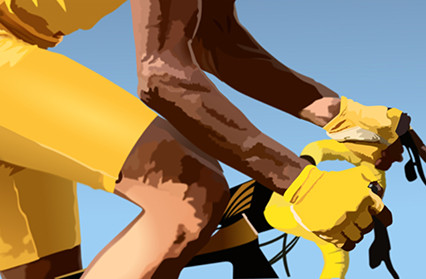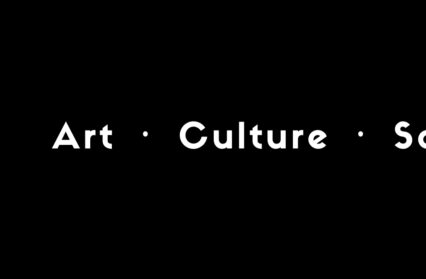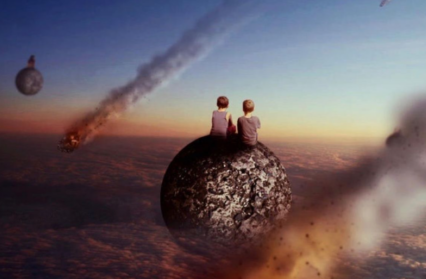The French writer JMG Arcimboldi is one of the great enigmas of twentieth century literature. Not least, his sudden retreat from public life remains unexplained. It has even been darkly suggested that the author’s disappearance may have been related to the so-called ‘barbaric writers’, whose founder, Raoul Delorme, Arcimboldi lived close to and had grown to fear due to rumours that Delorme performed Satanic rituals and black masses in the hope of improving his writing technique.
Like his life story, JMG Arcimboldi’s novels are impossible to pin down. Certainly, we can say his work was eclectic (he ‘seemed to subscribe to the maxim of De Kooning: style is a fraud’). The poet Padilla once said that whatever discernable style Arcimboldi does have is somewhere near the unlikely intersection of Aloysius Bertrand and Perec and (brace yourself) Gide and the Robbe-Grillet of Project for a Revolution in New York. In Barcelona, there are those who say that Arcimboldi is the perfect blend of Thomas Bernhard and R.L. Stevenson. While Riquer (1961) has been dismissed as long-winded Borges.
In one way or another, all of Arcimboldi’s stories are mysteries. And they are all ‘solved through flight, or sometimes through bloodshed (real or imaginary) followed by endless flight’. Attempting to make sense of them is pointless, which may well be the point.
Another Arcimboldi mystery is the story of his ‘lost’ début novel, The Enigma of the Cyclists of the Tour de France. The book was published by Gallimard in 1956. Beyond that, we know little. The first print run is likely to have been small. And perhaps then Arcimboldi himself saw that the book be suppressed. The author’s shame of his first-born.
All of Arcimboldi’s books are ‘French to the hilt’, so it is no surprise that he chose Le Tour as the subject of his first proper novel. The Tour de France – all of French history, all of French culture in one great big crazy bike race. Sport as metaphor for life, sport as metaphor for country: a well-worn literary trick.
And Arcimboldi was a serious cycling-fan. We know that he enjoyed an epistolary relationship with the Belgian polymath Robert Goffin in which they exchanged ten letters between 1948 and 1951 about Belgian and French cyclists (as well as touching on eroticism, painting, motoring, the weather, scams and great scam artists). But what is in his bike-racing novel? For Arcimboldi fans, The Enigma of the Cyclists of the Tour de France is the Holy Grail.
*
Of course, The Enigma of the Cyclists of the Tour de France is like the holy grail not because it is difficult to track down, but because, plain and simple, it does not exist.
That is because J.M.G. Arcimboldi is the creation of the genius Roberto Bolano. And all we know of the great Frenchman’s life and works we know of from the pages of Bolano’s posthumous novel Woes of the True Policeman (2011), a dazzling and dizzying book that is described in its introduction as being ‘an unfinished novel, but not an incomplete one.’
J.M.G. Arcimboldi (born Carcasonne, 1925) is similar to the more famous Benno von Archimboldi (born as Hans Reiter in Prussia, 1920) found in the pages of Bolano’s magnum opus 2666. There’s a J.M.G Arcimboldi in The Savage Detectives too. All three wrote a book called The Endless Rose. In Bolano’s intoxicating world(s), all three are the same and all are different – just as all of Bolano’s stories live alone and with each other.
Woes of the True Policeman includes a magnificent Borgesian section in which Bolano summarises many of Arcimboldi’s crazy-brilliant novels. But, alas, no words are given on The Enigma of the Cyclists of the Tour de France beyond its title, publisher and publication date. Let us hope that in the mass of papers Bolano left behind some scraps exist to explain Arcimboldi’s bike-racing novel.
Arcimboldi’s book is not literature’s only great unwritten cycling novel. In his memoir A Moveable Feast, Hemingway tells us of his plan to pen a bike-racing story: ‘I must write the strange world of the six-day races and the marvels of the road-racing in the mountains. French is the only language it has ever been written in properly and the terms are all French and that is what makes it hard to write.’
Grimpeur, puncheur, roleur, domestique, lache, danseuse, peloton, étape, musette, prologue, soigneur, pave, echelon, chasse patate, faux plat, hors catégorie, lanterne rouge, maillot jaune. The great climbs: Col du Galibier, Col d’Aubisque, Col d’Izoard, Col de la Madeleine, Alpe d’Heuz, Mont Ventoux. France’s heroes: Pottier, Anquetil, Hinault, Christophe, Leducq, Bobet, Petit-Breton, Thevenet, Poulidor, Darrigade, Jalabert, Fignon and, credit where it is due, Bassons. French authors, like Arcimboldi, can write of cycling as Americans can write of baseball, as the Welsh can write of rugby.
So without Arcimboldi’s and Hemingway’s books we must look elsewhere to find out what heady literature tells us of Le Tour and the enigmas of its riders.
Roland Barthes published his famous essay ‘The Tour de France as Epic’ in 1957. This was a year after Arcimboldi’s novel, so, with a little imagination, it is easy to see one book influencing the other. For Barthes, the Tour is ‘the best example we have ever encountered of a total, hence an ambiguous myth…The Tour expresses and liberates the French people through a unique fable’. Like Arcimboldi, Barthes sees Le Tour as a ‘world of characterial essences’. Even the mountain climbs have mystical personalities: ‘Ventoux is a god of Evil to which sacrifice must be made. A veritable Moloch, despot of the cyclists, it never forgives the weak and exacts an unjust tribute of sufferings.’
As for the nature of the riders, Coppi is the ‘Perfect hero’ and a ‘formidable ghost’, Darrigade is a ‘Repellent Cerberus, but useful’, Hassenforder is ‘the ardent warrior who knows nothing but fighting’ and Gaul ‘incarnates the Arbitrary, the Divine, the Marvellous, Election, complicity with the gods….the new archangel of the mountain.’ Of other cyclists’ myths, he adds: ‘Brankart, Geminiani, Lauredi, Antonin Rolland, these patronymics are read as algebraic signs of valour, loyalty, treachery or stoicism.’
Barthes searches for the secrets of the famous Bobet brothers. Of three-time Tour winner Louison, Barthes writes: ‘Bobet is an entirely human hero who owes nothing to supernature and derives his victories from purely earthly qualities, promoted by that humanist sanction par excellence: the will.’ Of the essence of the no-time Tour winner Jean, Barthes says: ‘Louison’s double is also his negative image; he is the great victim of the Tour…. This racer, ceaselessly demoralised, suffers from a serious infirmity: he thinks.’
Yes, Jean was a thinker. A good one. And he could really write too. Jean’s Tomorrow, We Ride is a brilliant memoir of a life in cycling. Bobet describes how he left his academic studies (at Aberdeen University, writing a doctorate on ‘The Hero in Hemingway’, which makes perfect sense) to become a professional cyclist. Tomorrow, We Ride provides a great insight into the inner-world of 1950s professional road-racing. This was the sport’s golden age: Coppi, Bartali, Kubler, Koblet, Gaul, Anquetil, Darrigade. Of course, Tomorrow, We Ride gives centre stage to the Bobets, a sibling relationship defined by their chosen sport: ‘We always understood each other best on bikes. We had always needed a bike beneath us.’
As he explains, Bobet was talked into switching from cycling to writing by Gallimard’s sporting director, Roger Nimier. Gallimard! Arcimboldi was there! His cycling book published by them in this period! Also on Gallimard’s staff at this time was Raymond Queneau, co-founder of the Oulipo writing movement. Indeed, Woes of The True Policeman tells us that Queneau played a central role in Arcimboldi’s career: ‘Raymond Queneau, whom he (Arcimboldi) considered to be his mentor and with whom he quarrelled at least ten times’. The influence of the intellectual and playful Queneau is obvious in Arcimboldi’s brilliant and bewildering unwritten-novels.
Another key figure in the Oulipo movement was Georges Perec, whom Arcimboldi ‘admired deeply’ – in fact, he ‘once remarked that Perec must surely be the second coming’. The Bobets have nice walk-on parts in Perec’s Je me souviens. Perec’s ‘Memory 17’ is of getting Louison’s autograph at the Parc des Princes and ‘Memory 138’ is that Jean had a degree in English. Wonderful to think of these great people’s paths crossing in the real and imaginary France of the time.
A more recent member of the Oulipo group is Paul Fournel, a man whose ‘entire youth was marked by the magic name of Campagnolo.’ Fournel’s wonderful Need for the Bike is a series of short essays that present a personal take on having cycling at the centre of one’s life. Amongst much else, Fournel takes in pro cycling’s greats and its not so greats: ‘We’re so busy watching the head of the pack we don’t see the dignity and the honour involved in simply being there, in the rhythm of the others’. This makes us note that Arcimboldi’s book is about the enigma of the riders of the Tour de France, not the winners of the Tour de France. Champions are a different breed, after all, or so we are told.
In search of the possible contents of Arcimboldi’s book, it’s worth looking at a few other of cycling’s most literary reads. Uwe Johnson’s meta-fictional novel The Third Book About Achim (1961) is about the attempted writing of a biography of a German cycling star. Johnson was a member of the Gruppe 47 literary movement that sought to explore the psyche of post-war Germany. An experimental novel about the writing of a biography and examining the fractures in German society – sport as sport, sport as metaphor – we might well be in Arcimboldi territory here (not least because Bolano himself was obsessed by Nazi history).
As we are searching for the enigma of Le Tour’s riders, a word should go to Master Jacques: The Enigma of Jacques Anquetil, in which Richard Yates looks at one of cycling’s most mysterious greats. This year’s Lanterne Rouge, by Max Leonard, and graphic novel Legends of the Tour, by Jan Cleijne, are also fine additions to any cyclist’s library.
Others from the long line of great books that go some way to exploring the personalities of cyclists include William Fotheringham’s Fallen Angel: The Passion of Fausto Coppi, Domestique, by Charly Wegelius, The Secret Race, by Tyler Hamilton and Daniel Coyle, The Death of Marco Pantani, by Matt Rendell, A Rough Ride by Paul Kimmage, A Dog in a Hat by Joe Parkin, and Coppi vs, Bartali at the 1949 Tour of Italy by Dino Buzzati. A special mention goes to One More Kilometre and We’re in the Showers by Tim Hilton, a superb mix of personal memoir and social history of bike-racing.
And while we might not have Hemingway’s bike story, it should be noted that a professional team does turn up for a few pages in his The Sun Also Rises, with Ottavio Bottecchia, the first Italian winner of the Tour de France (and someone who died in Arcimboldean circumstances) getting a mention.
But we will finish with perhaps the great cycling book. Dutchman Tim Krabbe’s The Rider (1978) is part history of bike racing, part account of the author’s own cycling exploits, and part fictional account of a rider, called Tim Krabbe, racing in the mythical Tour de Mont Aigoual (150 kilometres and five cols – the sweetest, toughest race of the season). It’s all brought together in a first-person narrative.
Krabbe himself was a serious amateur cyclist (as well as a serious amateur chess player). Like Bobet, Krabbe’s sporting experience and literary background mean he is better placed than most to put into words the thinking of serious cyclists. Krabbe does a magnificent job of taking us inside the dark mind of his cyclist. More than offering grand answers, The Rider peels away the myths to reveal the single-minded simplicity of the sportsman. Krabbe says that when cyclists talk of their motivations ‘the same thing always comes up: the best part was the suffering… because after the finish all the suffering turns to memories of pleasure, and the greater the suffering, the greater the pleasure.’ Perhaps these words point towards something of the secret of bike racers.
The singular mind of Krabbe’s rider has no time for the spectators: ‘Tourists and locals are watching from sidewalk cafes. Non-racers. The emptiness of those lives shocks me.’
Nor does Krabbe have time for the lazy myths and pop-psychology that goes so often with sport (as explored, and perhaps exemplified, by Barthes and Arcimboldi). At one point he spots a young girl cheering him on. In this jolting passage, he asks and answers:
What gives this girl the right to raise her voice?
..She’s the generation that no longer cheers for the riders, but for the journalistic cliché she recognises in them. Now that I’m five centimetres closer, I can see how pretty she really is. I hate her.
For her, road racing no longer exists. Road racing has gone into the cement mixer of journalism and come out again as the courage of the lone rider, as Poupou, doping doping, today the domestique must shine, Simpson on Mont Ventoux.
She belongs to the generation of emblems. She thinks I got my bicycle out of that cement mixer, that it’s an emblem I use to identify myself as a proponent of the ‘fitness’ rage….
Never will I be able to make clear to her that I don’t race because I wanted to lose weight, because turning thirty horrified me, because I was dissatisfied with cafe life, because I wanted to write this book, or because of anything else at all, but purely and simply because it’s road racing.
The enigma of the amateur racers and of the cyclists of the Tour de France might just be that they do it purely and simply because it’s road racing. This leads us to think that while J.M.G. Arcimboldi’s The Enigma of the Cyclists of the Tour de France is surely a great unwritten book, it is unlikely to explain the cyclists of the Tour de France. The secret of The Enigma of the Cyclists of the Tour de France (1956) is best found reading Bolano, Calvino, Borges, Aloysius Bertrand, Perec, Gide, Robbe-Grillet, Bernhard, R.L Stevenson, Cortazar and Uwe Johnson.
The secret to the enigma of the cyclists of the Tour de France is most likely to be found away from the library and out on the bike going on and on and up and up and up in the blazing sun or the wind and the hail. As Krabbe says: ‘That’s why there are riders. Suffering you need; literature is baloney.’
original illustration by Dean Lewis












